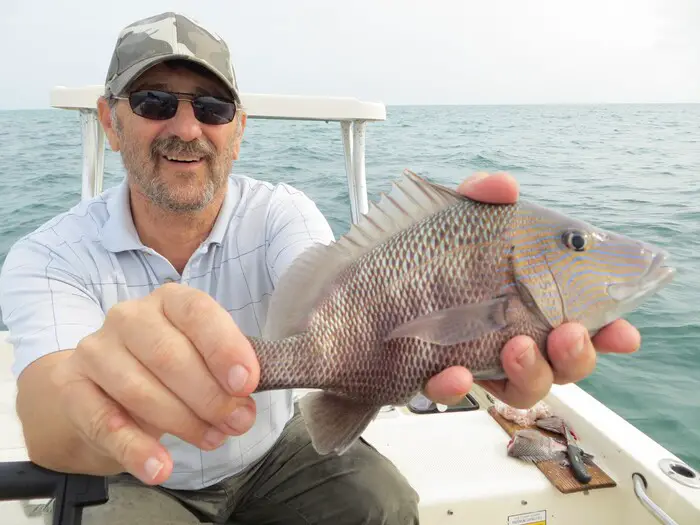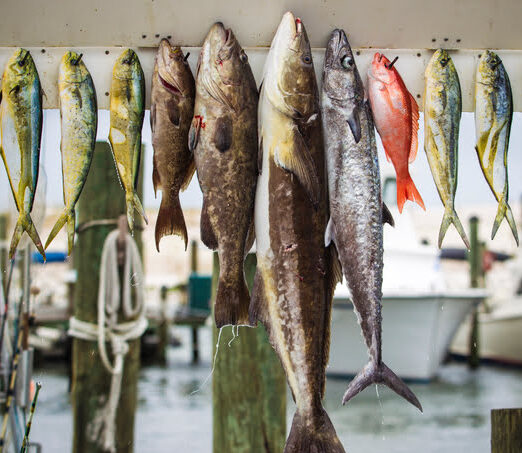Florida is known for its wide variety of seafood delicacies, with big names such as red snapper and snook known across the world for their delicious taste.
However, an underdog has been under the radar in the wider world for years: Grunts!
These fish weren’t often sought after for their meat outside of the Sunshine State, but that’s beginning to change as more people are realizing just how versatile they can be in the kitchen.
So are grunts good to eat?
Tie on your apron and grab your rod because it’s time to dig into the facts about this tasty fish family, and why native Floridians can’t get enough of ’em!
Table of Contents
- A Small Fish with Big Taste
- Florida’s Culinary History with Grunt Fish
- What Exactly Is a Grunt Fish?
- Conclusion
A Small Fish with Big Taste
The most commonly consumed species of grunt fish in Florida and the rest of the Southeastern U.S. is the white grunt (Haemulon plumieri), which is said to have a mild taste and tender, flaky white flesh.
The West coast’s primary grunt species is the sargo (Anisotremus davidsonii), which has a firmer texture to its meat but a similarly mild taste.
The exact flavor and texture vary from species to species, but the general consensus from anglers is that they’re all pretty darn good.
In fact, they’re what I refer to as blue-collar fish. They appeal to the hardworking blue-collar anglers, who would rather have fried grunts around a campfire then fancy sushi at a five-star restaurant.
And the taste reflects that. Grunts are not known for their subtle flavors or delicacy. They’re just good, medium-textured fish with a salty flavor that takes up seasoning and spices well.
If you live in a subtropical or tropical region by the coast, check to see what grunts live near you (and their fishing regulations) and how they taste for yourself!

Why Arean’t They More Popular?
One reason grunts are so often overlooked may be their small size; very few of them are large enough to provide full fillets, and the fillets you can get are pretty meager.
This is also why they aren’t usually fished commercially. However, if you’re willing to fry them whole, panfish style, you’re in for a tasty treat.
It should be noted that white grunts have been linked to ciguatera poisoning, caused when the fish eat toxic algae, making their meat dangerous to consume.
However, this is not unique to the grunt, and several species caught during these harmful algal blooms are not recommended to eat.
Checking the local conditions is always a smart move before eating anything you catch yourself!
Florida’s Culinary History with Grunt Fish
The Florida Keys are probably the best tropical angling hotspot in the continental U.S, and their residents seem to appreciate the humble grunt more than anywhere else!
For over 100 years, locals of the Keys have been making and enjoying one of their signature dishes, Grits and Grunts (or sometimes Grunts and Grits).
The dish has many variants and versions, but the common themes are that the grunt is seasoned to be hot and spicy.
The fish is often either poached or fried and can be served atop the grits or on the side.
Grits and Grunts is described as an “acquired taste” by many, but locals swear by it as a time-tested favorite!
The earliest references to this dish in literature date back to 1918 in Key West, and it’s referenced as an established local favorite, so it’s probably a lot older than that.
How To Cook Grunts
Grits and grunts is traditionally served as a quick breakfast meal. Because white grunt fish are so abundant in South Florida, they provided coastal residents with an easy and cheap way to get fresh fish in their diet before the age of refrigeration.
There are quite a few recipes available to try online but feel free to substitute your own favorite recipe for the grits, the grunts, or both if you have them.
Nowadays, the more universal “fish and grits” is consumed more often because it is easy to get fresh fish fillets from the grocery store and keep them fresh in the fridge.
Matching the seasoning and cooking methods can get you a similar taste to the original, but it’s perfectly acceptable to experiment and find a version you love!
This version of the dish may not be quite as traditional, but it tastes just as great.
Grunts were originally used out of pure convenience, so seafood section fillets bring the spirit of the original into the modern age!
What Exactly Is a Grunt Fish?
The grunt family Haemulidae consists of over 130 species inhabiting tropical and subtropical oceans worldwide.
While they may not look too special, they certainly sound special! As the name suggests, they are known to make a grunting sound that can be heard both in and out of the water.
The fish accomplishes this by grinding together a set of special teeth in its throat (called pharyngeal teeth) to create a clicking sound.
If you’ve ever been snorkeling in tropical waters and heard a distinct click click click noise, these chatty fish are likely your culprit.

Do You Love Seafood?
If you manage to catch a grunt, they can even make this sound out of the water when on the line! I can often feel them vibrate in my hands as I’m in the process of dehooking them.
I think that the clicks sound a lot like a small oinking pig, and apparently, others do too; one of the most common grunts on the U.S. Atlantic coast is even called the pigfish!
Conclusion
Trophy fishermen and commercial operations may scorn them, but those guys aren’t who grunts are for.
They’re for the recreational fisherfolk worldwide who want to enjoy a meal pulled from the sea by their own hands.
Whether you’re cooking Grits and Grunts Floridian-style or experimenting with your own recipes, you’ll follow countless chefs willing to turn overlooked ingredients into culinary masterworks.
Thanks for reading, and hooray for the humble grunt fish!
You May Also Like: Are Pinfish Good to Eat? You May Be Surprised!

Growing up in Florida, I’ve been surrounded by saltwater my entire life…and I love sharing my passion with others.
To learn more about why I started Saltwater Mecca, visit the ABOUT page.
Thank you for reading this article. Browse around & have some fun!